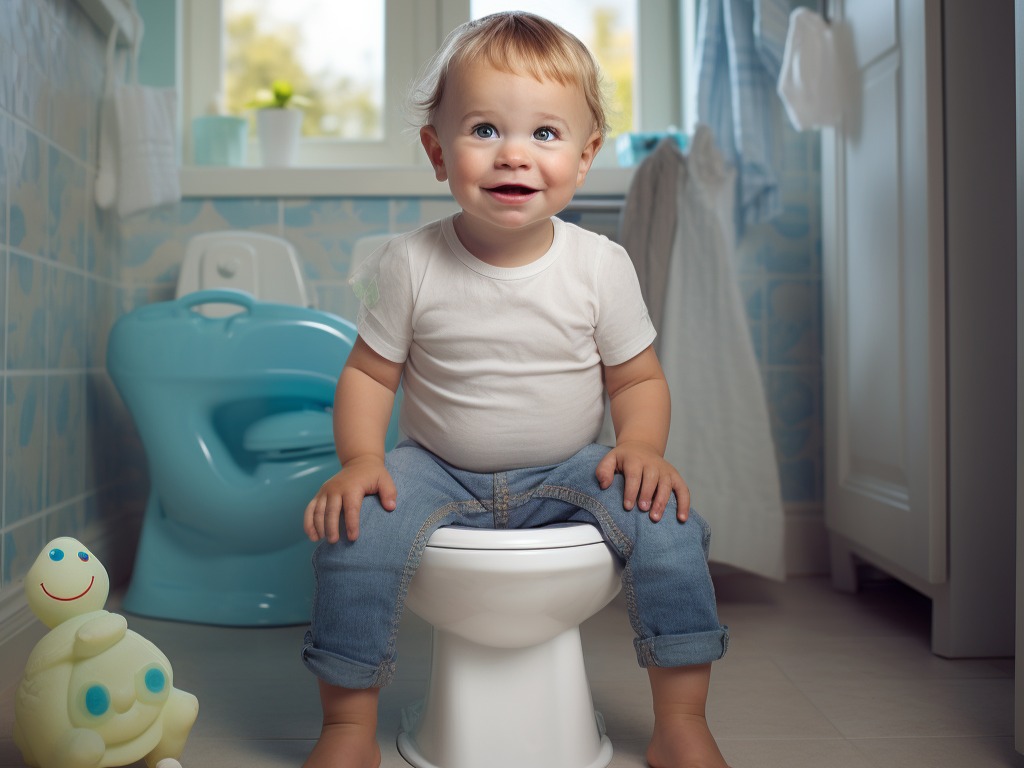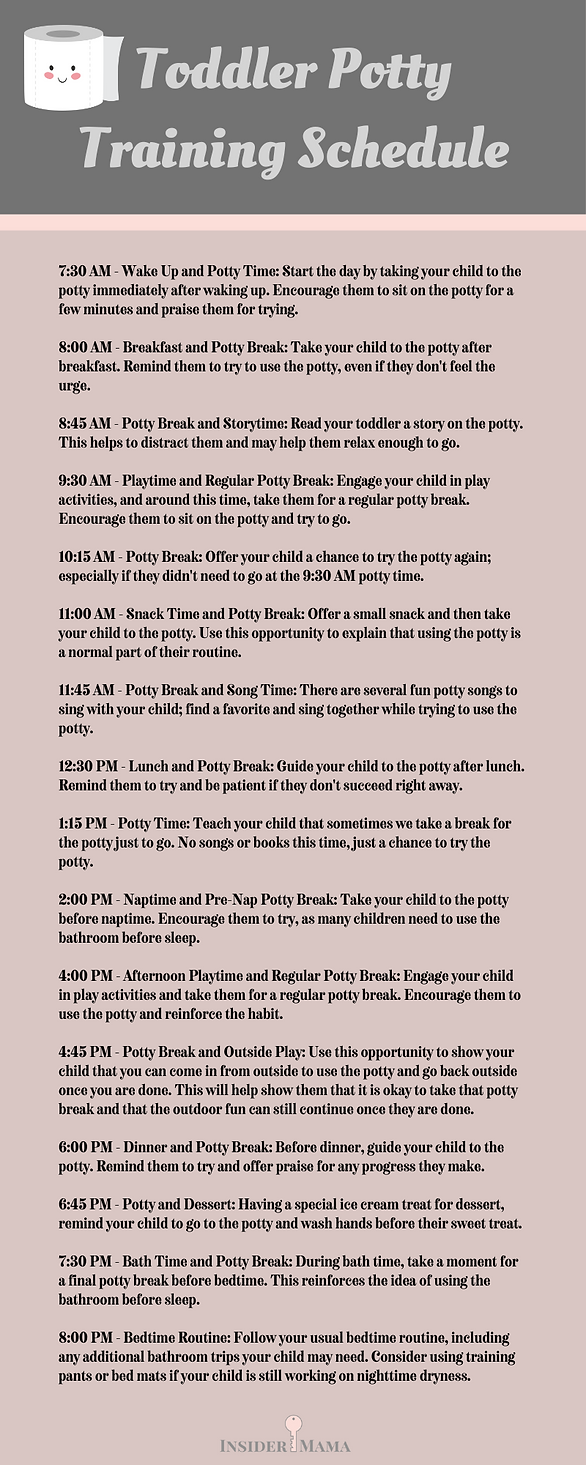Today we are talking about a topic that every parent eagerly awaits and nervously anticipates potty training. Ah, the elusive milestone that signifies a big step towards independence for our little ones. I’m a mom who has been through this before (five times to be exact) and is happy to offer advice and suggestions based on my experience.

The Readiness Checklist
Before we embark on the potty-training journey, it’s essential to determine if your child is truly ready. Every child is different, and readiness signs may vary, but here are some common indicators:
- Physical readiness: Look for signs that your child can control their bladder and bowel movements, such as staying dry for longer periods or showing discomfort when their diaper is soiled.
- Cognitive readiness: Your child should be able to understand and follow simple instructions. They should also exhibit an interest in the bathroom habits of others.
- Motor skills readiness: Potty training requires basic motor skills like pulling down pants, sitting on the potty, and wiping. Make sure your child has developed these abilities.
Preparing for the Potty Training Journey
Once you and your child are both ready, you can begin the potty-training process! Here’s what you need to do:
- Choose the right equipment: Invest in a child-sized potty chair or a potty seat that fits securely on your toilet. Let your child participate in selecting their special potty to build excitement.
- Stock up on supplies: Gather all the essentials, including training pants, wipes, hand soap, and perhaps a reward system like stickers or small treats to motivate your child.
- Create a potty-friendly environment: Make the bathroom an inviting place for your child by decorating it with colorful artwork, installing a step stool for easy access, and keeping their favorite books nearby.
Introducing the Concept of Going on the Potty
Congratulations! You’ve reached a pivotal moment in your parenting journey – the time has come to embark on the exciting adventure of potty training with your little one. Here are a few ideas to get you started:
- Storytime: Read age-appropriate books about potty training together. These stories often introduce the topic in a fun and relatable way, helping your child understand the process.
- Role-playing: Use dolls or stuffed animals to demonstrate how to use the potty. This interactive play can ease any anxieties your child may have and make the concept feel more familiar.
- Let them observe: Allow your child to observe you or an older sibling using the toilet whenever possible. This helps them understand that using the potty is normal in everyday life.
The Potty-Training Schedule: Establishing Consistency and Routine
One of the key factors in successful potty training is establishing a consistent schedule. A well-planned and structured routine will help your child understand expectations, recognize their body’s signals, and build a habit around using the potty.
Set Regular Potty Breaks:
To start, it’s essential to set regular potty breaks throughout the day. Begin by taking your child to the potty every 30-60 minutes, even if they don’t feel the urge to go. This consistent routine helps them become familiar with the process and reinforces the habit of using the potty. As your child becomes more comfortable, you can gradually increase the time between potty breaks.
Timing is Key:
Pay attention to your child’s natural bodily rhythms. Most children are more likely to need to use the bathroom after meals, upon waking up, or before bedtime. Take advantage of these times by incorporating potty breaks into their daily routine. For example, after breakfast, take a trip to the potty to encourage a bowel movement.
Encourage Bathroom Visits:
In addition to the regular potty breaks, encourage your child to visit the bathroom in certain situations. For instance, before leaving the house, before naptime or bedtime, and upon returning home. They gain a better understanding of the fact that using the potty is a necessary part of their daily routine regardless of where they are because of this.
Be Observant:
Observe your child’s behavior and body language for signs that they may need to use the potty. They may start doing a “potty dance,” squirming or holding their genital area. When you notice these signs, act promptly and guide them to the potty. This not only reinforces their body’s signals but also prevents accidents.
Stay Consistent:
Consistency is key during potty training. Ensure that everyone involved in your child’s care, such as caregivers or family members, follows the same schedule and approach. This consistency helps your child understand that using the potty is an expectation that remains the same, regardless of who is around.
Nighttime Training:
Nighttime training requires a slightly different approach. While some children naturally develop nighttime dryness along with daytime control, others take longer. Limit your child’s fluid intake before bedtime, encourage them to use the potty before sleep, and consider using training pants or bed mats to protect against accidents. Being patient during this phase is important, as nighttime dryness often takes longer to achieve.
Adapt and Adjust:
Keep in mind, mamas, that there is no “one size fits all” approach to raising children. Be flexible and willing to adapt your schedule as needed. If you notice your child consistently resisting or showing signs of stress during certain potty breaks, it may be necessary to reassess the timing and adjust the schedule accordingly.
Patience and Positive Reinforcement:
Maintaining a patient and positive attitude is crucial throughout the potty-training journey. Praise your child for their efforts, even if they don’t succeed every time. Offer encouragement, celebrate their successes, and provide reassurance during setbacks. A loving and supportive approach will make the process more enjoyable for both of you.
Remember, creating a potty-training schedule is about finding a balance between structure and flexibility. While consistency is key, it’s also important to listen to your child’s cues and adjust the schedule as needed. With time, patience, and a consistent routine, your little one will master the art of using the potty and achieve this significant milestone in their development.

Potty-Training Schedule
You can modify this sample potty-training schedule to fit your child’s needs and your own schedule as you progress through the process.
7:30 AM – Wake Up and Potty Time: Start the day by taking your child to the potty immediately after waking up. Encourage them to sit on the potty for a few minutes and praise them for trying.
8:00 AM – Breakfast and Potty Break: Take your child to the potty after breakfast. Remind them to try to use the potty, even if they don’t feel the urge.
8:45 AM – Potty Break and Storytime: Read your toddler a story on the potty. This helps to distract them and may help them relax enough to go.
9:30 AM – Playtime and Regular Potty Break: Engage your child in play activities, and around this time, take them for a regular potty break. Encourage them to sit on the potty and try to go.
10:15 AM – Potty Break: Offer your child a chance to try the potty again; especially if they didn’t need to go at the 9:30 AM potty time.
11:00 AM – Snack Time and Potty Break: Offer a small snack and then take your child to the potty. Use this opportunity to explain that using the potty is a normal part of their routine.
11:45 AM – Potty Break and Song Time: There are several fun potty songs to sing with your child; find a favorite and sing together while trying to use the potty.
12:30 PM – Lunch and Potty Break: Guide your child to the potty after lunch. Remind them to try and be patient if they don’t succeed right away.
1:15 PM – Potty Time: Teach your child that sometimes we take a break for the potty just to go. No songs or books this time, just a chance to try the potty.
2:00 PM – Naptime and Pre-Nap Potty Break: Take your child to the potty before naptime. Encourage them to try, as many children need to use the bathroom before sleep.
4:00 PM – Afternoon Playtime and Regular Potty Break: Engage your child in play activities and take them for a regular potty break. Encourage them to use the potty and reinforce the habit.
4:45 PM – Potty Break and Outside Play: Use this opportunity to show your child that you can come in from outside to use the potty and go back outside once you are done. This will help show them that it is okay to take that potty break and that the outdoor fun can still continue once they are done.
6:00 PM – Dinner and Potty Break: Before dinner, guide your child to the potty. Remind them to try and offer praise for any progress they make.
6:45 PM – Potty and Dessert: Having a special ice cream treat for dessert, remind your child to go to the potty and wash hands before their sweet treat.
7:30 PM – Bath Time and Potty Break: During bath time, take a moment for a final potty break before bedtime. This reinforces the idea of using the bathroom before sleep.
8:00 PM – Bedtime Routine: Follow your usual bedtime routine, including any additional bathroom trips your child may need. Consider using training pants or bed mats if your child is still working on nighttime dryness.
Throughout the day, remain observant of your child’s cues and adjust the schedule as needed. Mamas, just remember that this is just an example and you can always make changes to fit your own child and family, okay? The key is to establish consistency and make using the potty a regular part of their daily life.
Troubleshooting and Tips
Here are some common challenges you may encounter during potty training, along with tips to overcome them:
Accidents happen: Stay calm and avoid scolding or punishing your child for accidents. Instead, reassure them that it’s okay and encourage them to try again next time.
Nighttime training: Nighttime dryness takes longer to achieve. Limit fluid intake before bedtime, encourage bathroom trips before sleep, and consider using training pants or bed mats until your child is consistently dry through the night.
Dealing with regressions: Regression is normal during potty training. If your child starts having accidents again after showing progress, offer support, and maintain consistency. It’s just a temporary setback.
Celebrating Milestones
As your child masters the art of potty training, celebrate their milestones and successes. Remember, this journey is not just about achieving dryness; it’s about fostering independence and building confidence. Take pride in every small victory along the way.
Final Thoughts – Sharing the Wisdom
Congratulations! You’ve successfully potty-trained your child, and you’re now armed with a wealth of knowledge and experience. Don’t forget to share your wisdom with other moms who might be starting their potty-training journeys. Your insights and support can make all the difference.




